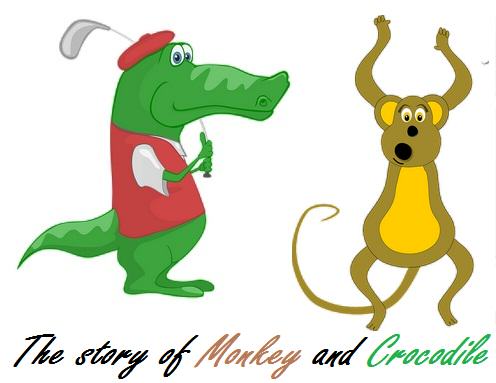Example of Narrative Text with Direct Speeches – Monkey and Crocodile
English admin – The story of monkey and crocodile is best fable for learning narrative text relating to direct and indirect speech contents. Most stories are written in these two kinds; direct and indirect. So when learning narrative stories, student must have good understanding on direct or indirect speech for English grammar.
Narrative text is often a story. A story is exploring participants thought, act and feeling. To gain that goal, narrative text will be arranged in lot of direct speeches. The following narrative text is structured clearly.
Generic Structure of Narrative Text on the Story of Monkey and Crocodile
1. Orientation: The participants or characters of the story are a smart monkey and dull crocodile.
One day there was a monkey. He wanted to cross a river. There he saw a crocodile
The time set is just one day. The story takes place in a river
2. Complication: Every narrative text must consist of conflict or problem. A simple definition of problem is when something goes and it is not what we want. In the story the complication start when the crocodile want to eats the monkey.
the crocodile was very hungry, he stopped in the middle of the river and said to the monkey, “My father is very sick. He has to eat the heart of the monkey.
Of course the monkey don not want to be the crocodile’s meal and that is the problem which sets the whole story.
3. Resolution: A problem must be resolved. It can succeed or fail. In this story, the monkey succeeds to solve the problem. He get free from the hungry crocodile.
The crocodile agreed and turned around. He swam back to the bank of the river. As soon as they reached the river bank, the monkey jumped off the crocodile’s back. Then he climbed up to the top of a tree.
To have clear understanding, take a look at the following example of narrative text about the way of a smart monkey getting free from from a hungry dull crocodile.
The Story of Smart Monkey and Dull Crocodile

Example of narrative with generic structure – story of monkey and crocodile
One day there was a monkey. He wanted to cross a river. There he saw a crocodile so he asked the crocodile to take him across the other side of the river. The crocodile agree and told the monkey to jump on its back. Then the crocodile swam down the river with the monkey on his top.
Unluckily, the crocodile was very hungry, he stopped in the middle of the river and said to the monkey, “My father is very sick. He has to eat the heart of the monkey. So he will be healthy again.”
At the time, the monkey was in dangerous situation and he had to think hard. Then he had a good idea. He told the crocodile to swim back to the river bank. “What’s for?” asked the crocodile. “Because I don’t bring my heart,” said the monkey. “I left it under a tree, near some coconuts in the river bank.”
The crocodile agreed and turned around. He swam back to the bank of the river. As soon as they reached the river bank, the monkey jumped off the crocodile’s back. Then he climbed up to the top of a tree.
“Where is your heart?” asked the crocodile. “You are foolish,” said the monkey to the crocodile. “Now I am free and I have my heart.”




